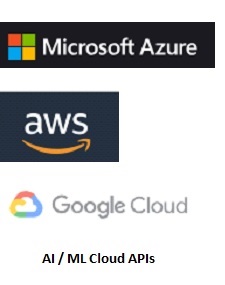Most of us start working with specific programming languages like TensorFlow and Pyspark
So, we are relatively not so used to working with Cloud APIs.
But Cloud APIs for Machine Learning and Deep Learning can make your life a lot easier in building AI and Machine Learning services
Of course, the Cloud APIs have a cost – but they enable an ease of use for creating new services
At my course in the University of Oxford (Data Science for Internet of Things course), this year, we made extensive use of Cloud APIs for Cloud Robotics
In this post, we introduce the three major cloud APIs
Microsoft Azure Cognitive services
Its easy to get started with these three services
Getting started with azure cognitive services
AWS build machine learning models
Details of the specific APIs are
AWS
- Recommendations (Amazon personalize): Personalize experiences for your customers with the same recommendation technology used at Amazon.com.
- Forecasting (Amazon forecast): Build accurate forecasting models based on the same machine learning forecasting technology used by Amazon.com.
- Transcription (Amazon Transcribe): Easily add high-quality speech-to-text capabilities to your applications and workflows.
- Image and Video Analysis (Amazon recognition): Add image and video analysis to your applications to catalog assets, automate media workflows, and extract meaning.
- Advanced Text Analytics (Amazon comprehend): Use natural language processing to extract insights and relationships from unstructured text.
- Conversational Agents (Amazon Lex): Easily build conversational agents to improve customer service and increase contact center efficiency.
- Document Analysis (Amazon textract): Automatically extract text and data from millions of documents in just hours, reducing manual efforts.
- Voice (Amazon Polly) : Turn text into lifelike speech to give voice to your applications.
- Translation (Amazon Translate): Expand your reach through efficient and cost-effective translation to reach audiences in multiple languages.
- Transcription (Amazon Transcribe): Easily add high-quality speech-to-text capabilities to your applications and workflows.
Google Machine Learning APIs
- Cloud Vision API: Integrates Google Vision features, including image labeling, face, logo, and landmark detection, optical character recognition (OCR), and detection of explicit content, into applications.
- Cloud Speech API: Uses fast and accurate speech recognition to convert audio, either from a microphone or from a file, to text in over 80 languages and variants
- Natural Language API: Analyzes the structure and meaning of text, including sentiment analysis, entity recognition, and text annotations.
- Translation API: Translates text from one language to another.
- Dialogflow API: An end-to-end development suite for conversational interfaces (e.g., chatbots, voice-powered apps and devices).
Azure Cloud
- Image-processing algorithms: to smartly identify, caption and moderate your pictures.
- Speech: Convert spoken audio into text, use voice for verification or add speaker recognition to your app.
- Knowledge: Map complex information and data in order to solve tasks such as intelligent recommendations and semantic search.
- Search: Add Bing Search APIs to your apps and harness the ability to comb billions of web pages, images, videos and news with a single API call.
- Language: Allow your apps to process natural language with pre-built scripts, evaluate sentiment and learn how to recognise what users want.
Our experience
- Our overall experience has been positive. APIs are very easy to use
- The functionality is similar across platforms
- If you work with Python, it was easy to use all three
- Mostly, Cloud APIs are language agnostic i.e. support major ML languages/paradigms
To conclude, the Cloud paradigm is gaining rapid traction. Our early experience was good and we are exploring further.
Comments welcome

